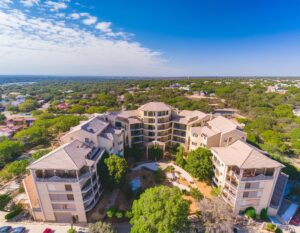- Demand Decline: Over the past 12 months, multifamily demand in San Antonio has significantly weakened, evidenced by negative quarterly net absorption throughout the last year—a first for the city.
- Increase in Vacancies: Due to the continued release of new supply amidst weakened demand, vacancy rates have increased from a historic low of 6.1% in Q4 2021 to 10.8%.
- Rent Growth Deceleration: The weakening demand and rising vacancies have led to a sharp deceleration in annual rent growth, which had previously seen double-digit gains in 2022.
- Improving Absorption: Absorption rates have improved as the market adjusts to new, amenitized units, and historically high inflation begins to subside.
- Wave of Development: San Antonio is preparing for a significant wave of apartment development, with around 19,000 units in progress, focusing on high-growth areas like the Far West Submarket, New Braunfels, and the Pearl area.
- Population Growth: San Antonio remains one of the fastest-growing cities in the U.S., continuing to attract new residents despite a national slowdown in population growth.
- Capital Markets Attraction: The city’s strong demographic momentum has made it a regular target for investors. However, recent months have seen a slowdown in transaction activity due to rising interest rates and a widening bid-ask spread.
- Adjusting Property Values: Property values, particularly in the 4 & 5 Star inventory, have decreased from $220,000 per door to around $190,000, reflecting the current economic conditions.
- Potential for Market Resilience: The lower property prices in an already affordable market may increase transaction activity, helping to stabilize the market as it navigates ongoing macroeconomic challenges.
- Strategic Market Focus: Most new development is strategically concentrated in specific growth nodes within the city, leveraging areas with solid market fundamentals to optimize potential returns and absorption.
Page Contents
- Market Overview: Shifting Dynamics in Multifamily Demand
- Impact of National Trends on Local Markets
- Construction Trends: A Double-Edged Sword
- The Role of Alternative Housing Options
- Long-term Prospects Amidst Short-term Challenges
- Rent Growth Moderation
- Construction and Development Focus
- Homeownership as Competition
- Response of New Multifamily Properties
- Supply Challenges in San Antonio’s Real Estate Market
- Geographical Spread of Development Projects
- Inventory Growth and Developer Confidence
- Connecting the Developments
- San Antonio’s Appeal to Investors
- Highlighting Major Transactions: Costa Bella Apartments
- Representative Sales Trends: Avenues at Creekside
- Analyzing Market Dynamics
- Closing Thoughts
Market Overview: Shifting Dynamics in Multifamily Demand
Apartment demand in San Antonio has shown a surprising downturn, with the current 12-month net absorption at 1,400 units. This starkly contrasts from just over a year ago when annual net absorption neared 11,000 units. The current market scenario presents a vastly different picture with an influx of new units, raising questions about the time required to absorb an additional 19,000 units en route to the market.
Impact of National Trends on Local Markets
 The broader national market normalization influences San Antonio’s multifamily sector. Although people often blame local economic dynamics, the rise in vacancies to 11.0% aligns with trends observed in similar Sun Belt cities. This comparison suggests that San Antonio’s market changes are not isolated but part of a broader regional pattern.
The broader national market normalization influences San Antonio’s multifamily sector. Although people often blame local economic dynamics, the rise in vacancies to 11.0% aligns with trends observed in similar Sun Belt cities. This comparison suggests that San Antonio’s market changes are not isolated but part of a broader regional pattern.Construction Trends: A Double-Edged Sword
San Antonio’s construction-friendly environment has increased development, notably higher than in more geographically constrained cities. While this encourages economic activity and provides new housing options, it also contributes to the rising vacancy rates, surpassing the national average and reflecting the challenges of managing supply in an ‘easy-to-build’ market.
The Role of Alternative Housing Options
The availability of affordable, for-rent single-family homes presents a significant challenge to multifamily units. In San Antonio, where newcomers often look for more space, cars, and yards, single-family rentals compete directly with multifamily offerings, influencing vacancy rates and market dynamics in the multifamily sector.
Long-term Prospects Amidst Short-term Challenges
Despite short-term absorption issues, long-term demand for multifamily units in San Antonio remains strong. Recent population estimates underscore the city’s growth, surpassing other major cities like Nashville and Austin. Despite current market fluctuations, this population increase is a fundamental tailwind, promising sustained demand in the multifamily sector.
Rent Growth Moderation
Rent growth in San Antonio has nearly stalled, decreasing by 1.1% over the past year. Household formation slowed significantly after an exceptional year in 2021, impacting demand for multifamily units. As 2023 progresses, the market may adjust towards more typical rent growth levels.
Construction and Development Focus
 San Antonio’s multifamily construction has historically concentrated in the Far West and Northwest submarkets. These areas saw significant development activity during the 2010s. However, emerging multifamily markets in 2023 include Downtown, Midtown, Southeast, and Northeast San Antonio, along with Comal and Guadalupe counties, attracting more development and tenant interest due to their diverse offerings and geographic appeal.
San Antonio’s multifamily construction has historically concentrated in the Far West and Northwest submarkets. These areas saw significant development activity during the 2010s. However, emerging multifamily markets in 2023 include Downtown, Midtown, Southeast, and Northeast San Antonio, along with Comal and Guadalupe counties, attracting more development and tenant interest due to their diverse offerings and geographic appeal.Homeownership as Competition
Homeownership remains a formidable competitor to renting, even with higher interest rates. While single-family home prices have slightly declined and sales volumes have dropped, San Antonio still ranks among the top locations where renters are transitioning to homeownership. This trend constrains landlords’ ability to raise rents during lease renewals.
Response of New Multifamily Properties
New multifamily developments in San Antonio are enhancing their appeal to potential tenants. They emphasize community, access to amenities, and proximity to desirable mixed-use areas. Despite the suburban sprawl, new, high-quality multifamily units can maintain demand by offering features that single-family homes, especially those in car-dependent areas, cannot match. This strategic positioning helps sustain rent growth despite competitive pressures from the homeownership sector.
Supply Challenges in San Antonio’s Real Estate Market
San Antonio faces significant supply-side risks with the largest construction pipeline in its history. As of summer 2023, numerous developments proceed, though financing challenges are mounting. With 19,000 units under construction, primarily in the luxury segment, the saturated market is experiencing stalled rent growth among high-end apartments.
Geographical Spread of Development Projects
Recent multifamily developments have spread more geographically across San Antonio than in previous years. Historically concentrated in the Northwest and Far West, development has expanded to Downtown, Northeast, and Southeast areas. This diversification reflects a strategic shift by developers to tap into various submarkets, possibly alleviating some pressures in over-saturated areas.
Inventory Growth and Developer Confidence
Downtown, Comal County, and Far West San Antonio have seen the fastest inventory growth from 2010 to 2022. Despite higher costs, these areas continue to attract development, showing strong lease-up rates and developer confidence. Even as financing becomes more challenging, the commitment to these high-growth areas remains robust, suggesting a bullish outlook on their long-term viability.
Connecting the Developments
The shift in development strategy in San Antonio, from concentrated efforts in traditional areas to a more diversified approach across new submarkets, addresses both the challenges of an oversupplied luxury segment and the opportunities in the emerging regions. By expanding into Downtown and other growing neighborhoods, developers are managing risk and capitalizing on the broader demand across the city. This strategy might balance the supply issues and maintain healthy growth in the real estate market despite current financial hurdles.
San Antonio’s Appeal to Investors
San Antonio, a “Super Sun Belt” city, attracts significant investment in multifamily properties. The influx of national and institutional investors has driven prices to record highs, although 2023’s rising interest rates have impacted deal volumes and transaction prices. Currently, average prices hover around $140,000 per unit, with premium assets fetching up to $180,000.
Highlighting Major Transactions: Costa Bella Apartments
The sale of Costa Bella Apartments marks a notable transaction in San Antonio’s real estate market. Sold by Starwood Capital Group to GVA Management for approximately $150 million, this sale represents the highest price for a multifamily asset in the area over the past decade. Located in the affluent Rogers Ranch, Costa Bella boasted a 96% occupancy rate at the time of the sale.
Representative Sales Trends: Avenues at Creekside
A more typical sale reflecting current market conditions is the Avenues at Creekside. Sold for $93 million by Sherman Residential to Ilan Investments, this transaction priced at $235,000 per door underlines the strong demand for luxury multifamily units. Located in New Braunfels along the I-35 corridor, the property features high-end amenities and maintains a low vacancy rate of 4%.
Analyzing Market Dynamics
These transactions illustrate the diverse dynamics in San Antonio’s multifamily market. The contrast between the high sale price of Costa Bella and the more typical pricing of Avenues at Creekside demonstrates the variability in the market based on location and amenities. Despite fluctuating interest rates affecting overall investment enthusiasm, specific areas and properties continue to attract significant investor interest, maintaining strong occupancy and high transaction values.
Closing Thoughts
In conclusion, despite economic fluctuations, San Antonio’s multifamily market continues to attract substantial investment. Key transactions like Costa Bella and Avenues at Creekside exemplify the robust demand and diverse opportunities within this vibrant “Super Sun Belt” city. For those looking to navigate this promising market, partnering with a knowledgeable ally is crucial. Contact Lumicre for your investment needs and leverage our expertise to capitalize on these opportunities.